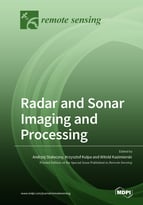Radar and Sonar Imaging and Processing
A special issue of Remote Sensing (ISSN 2072-4292). This special issue belongs to the section "Remote Sensing Image Processing".
Deadline for manuscript submissions: closed (31 December 2019) | Viewed by 89298
Special Issue Editors
Interests: radar navigation; comparative (terrain-based) navigation; multi-sensor data fusion; radar and sonar target tracking; sonar imaging and understanding; MBES bathymetry; ASV; artificial neural networks; geoinformatics
Special Issues, Collections and Topics in MDPI journals
Interests: DSP, RADAR, remote sensing
Interests: target tracking; data fusion; maritime radars; spatial analysis; artificial neural networks; mobile cartography
Special Issues, Collections and Topics in MDPI journals
Special Issue Information
Dear Colleagues,
Over the past years, radar and sonar technology has been at the center of several major developments in remote sensing both in civilian and defense applications. Although radar technology has been known for more than 100 years, it is still developing and it is now implemented in many maritime, air, satellite, and land applications. New technologies such as sparse image reconstruction and multistatic active and passive SAR and ISAR imaging are changing the quality of images and areas of applications. The rapid development of automotive radars in 3D dimensions, able to recognize different objects and assign the risk of collision, is one example of the progress of this technology. In maritime radars, the application of FMCW technology is becoming more and more popular, aside from classical pulse radars. Simultaneously, sonar technology has also been used for dozens of decades, at the beginning only for military solutions but, today, using 3D versions, it is used for many underwater tasks, such as underwater surface imaging, target detections, and tracking, among others. The impact of sonar technologies has been growing, particularly at the beginning of autonomous vehicles era. Recently, the influence of artificial intelligence for radar and sonar image processing and understanding has emerged. Radar and sonar systems are mounted onboard of smart and flexible platforms and also on several types of unmanned vehicles. Both of these technologies focus on remote detection of targets and both may encounter many common scientific challenges. Unfortunately, specialists from the radar and sonar fields do not interact with each other, slowing down progress in both areas.
This Special Issue will report the latest advances and trends in the field of remote sensing for radar and sonar image processing, addressing original developments, new applications, and practical solutions to open questions. The aim is to increase the data and knowledge exchange between those two communities and allow experts from other areas to understand the radar and sonar problems. Topics for this Special Issue include, but are not limited to, the following:
- Passive and active radar imaging (SAR, ISAR)
- Passive, bistatic, and multi-static radar imaging
- 3D radar and 3D sonar imaging
- Sonar image processing, data reduction, feature extraction, and image understanding
- Interferometric methods
- Sparse image reconstruction
- Automatic target detection and classification
- Radar sensors design and platform developments
- Radar and sonar target tracking and anti-collision algorithms and methods
- Multi-sensor data fusion
- Synergy between radar, sonar, and other sensors
- Radar and sonar base autonomous navigation
- Ground Penetrating Radar application in civil engineering
- Automotive and maritime radar
- Radar and sonar surveillance systems
- Side scan sonar, imaging sonar, chirp sonar, and forward-looking sonar
- Artificial Intelligence for radar and sonar data processing
Prof. Dr. Krzysztof Kulpa
Dr. Witold Kazimierski
Guest Editors
Manuscript Submission Information
Manuscripts should be submitted online at www.mdpi.com by registering and logging in to this website. Once you are registered, click here to go to the submission form. Manuscripts can be submitted until the deadline. All submissions that pass pre-check are peer-reviewed. Accepted papers will be published continuously in the journal (as soon as accepted) and will be listed together on the special issue website. Research articles, review articles as well as short communications are invited. For planned papers, a title and short abstract (about 100 words) can be sent to the Editorial Office for announcement on this website.
Submitted manuscripts should not have been published previously, nor be under consideration for publication elsewhere (except conference proceedings papers). All manuscripts are thoroughly refereed through a single-blind peer-review process. A guide for authors and other relevant information for submission of manuscripts is available on the Instructions for Authors page. Remote Sensing is an international peer-reviewed open access semimonthly journal published by MDPI.
Please visit the Instructions for Authors page before submitting a manuscript. The Article Processing Charge (APC) for publication in this open access journal is 2700 CHF (Swiss Francs). Submitted papers should be well formatted and use good English. Authors may use MDPI's English editing service prior to publication or during author revisions.
Keywords
- radar
- sonar
- data fusion
- sensors design
- target tracking
- target imaging
- image understanding and target recognition
Related Special Issue
- 2nd Edition Radar and Sonar Imaging and Processing in Remote Sensing (15 articles)








